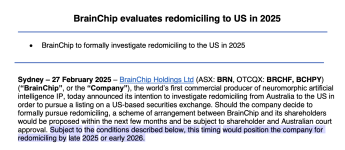Our partner Mirle gets a mention in this recent article titled
"Taiwanese firms vital to NVIDIA's humanoid robots."
As we know, BrainChip is currently collaborating with Chelpis Quantum and Mirle to develop an AI‑PQC (Post‑Quantum Cryptography) System-on-Chip. This SoC integrates a RISC‑V CPU, a PQC accelerator, and BrainChip’s Akida neuromorphic core. The project’s initial focus is autonomous quadruped robotics for industrial environments.
I have also highlighted the excerpt which cites TSMC CEO C.C. Wei, who reportedly said “conversations with customers reveal that business opportunities for humanoid robots will be ten times greater than those of electric vehicles.”
Mirle is already embedded in NVIDIA’s ecosystem, actively contributing to simulation and robotic model training using NVIDIA’s Omniverse and Isaac platforms for 3D modeling, simulation, and workflow automation.
With Mirle already working closely within NVIDIA’s robotics ecosystem, hopefully there'll be a compelling case in future for NVIDIA to explore how Akida-powered hardware can enhance its stack. Akida’s ultra‑low‑power, event-based inference and embedded security capabilities would complement NVIDIA’s high-performance platform, potentially forming a powerful, end-to-end robotics solution IMO.
Taiwanese firms vital to Nvidia's humanoid robots
Taiwan rushes to develop supply chain for producing human-like robots
Jul. 20, 2025 15:43
TAIPEI (Taiwan News) — Taiwanese manufacturers like Foxconn and others are aiding Nvidia in developing humanoid robots.
The companies aim to establish a complete supply chain, ranging from chips to software, robot joints, and motors.
Nvidia founder Jensen Huang said robotics technology would be Nvidia's largest potential growth market outside of AI at an address to shareholders in June. During his visit to Taiwan later that month, he said breakthroughs in humanoid robots and AI were coming at the right time.
In particular, Nvidia's next-generation Thor Blackwell Robotics Processor was specially designed for use in automated handling machines, essentially becoming the "brain" of humanoid robots. While Huang believes his company has the know-how to power humanoid robots, actual market conditions may still be far behind.
Analysts are cautious about the development of the humanoid robot industry. Digitimes
reported that humanoid robots will only account for 0.2% of the global robot market this year and expand to 2% by 2030.
TSMC CEO C.C. Wei, an important foundry partner of Nvidia's AI chips, said it is "too early" for humanoid robots to play a key role in industry growth this year because of complex design and development. However, he said, conversations with customers reveal that business opportunities for humanoid robots will be ten times greater than those of electric vehicles.
Foxconn has worked with Nvidia to develop key robotics technologies and has launched a complete robotics manufacturing platform. Foreign media have also reported that Foxconn and Nvidia discussed deploying humanoid robots in a new factory in Houston, Texas, to manufacture Nvidia's AI servers.
Taiwanese manufacturers are also actively deploying key components for humanoid robots. Yulong, a precision parts machining plant, developed micro harmonic drives for humanoid robot fingers and rotary actuators, which it hopes to ship to European and US customers in 2026.
Taiwan's Apex Dynamics is also optimistic about humanoid robots and is planning to develop customized mass production capabilities for humanoid robot joint modules. According to market analysts, the company could begin shipping as early as the fourth quarter.
Automation solution provider Mirle has joined hands with several local companies to develop and manufacture joint modules and harmonic drive systems. Chieftek Precision, the producer of linear guides and motors, has developed both general and special joints for humanoid robots.
Taiwan rushes to develop supply chain for producing human-like robots | Jul. 20, 2025 15:43

www.taiwannews.com.tw
View attachment 88752
View attachment 88751
View attachment 88753
Directly below that, you can see the BrainChip logo, which confirms the presence of Akida neuromorphic technology.
This is likely a Renesas + BrainChip evaluation board, designed to demonstrate edge AI capabilities using:
The display module also suggests this kit is made for HMI (Human-Machine Interface) or visual AI demos, such as gesture recognition, object detection, or keyword spotting – all low-power use cases where Akida shines.




